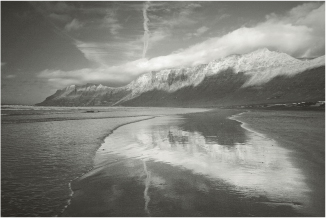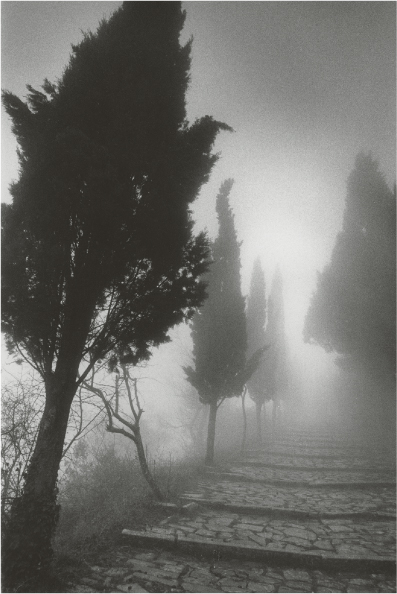5 Why Are Moods So Important?
Just as in music, emotions can be expressed in photography. How is it possible to capture emotions using an image sensor and to generate tones and gray tones that equal the major or minor keys of the music scale?
There are many expensive cameras on the market that can give us the highest technical pictorial quality, but even these outstanding cameras cannot create atmospheric photos; only the person behind the camera can do that. The photographer can compose a perception of the world in a tight image. Well, what makes a tight image? First, it is the pictorial content, but it is how you place that content in the image that determines the impact it will have. The three photos taken at a beach in Lanzarote (figures 5–1, 5–2, and 5–3) show how different the same content can look.
As in music, images are perceived mostly at the sentimental level. Music conveys emotions that can move us to different states. This is hardly any different in photography. Images show us realistic content, but these are wrapped in emotions, as in music. And, these emotions are communicated to the viewer in the same way in which a concert attendee hears the emotional tones of a musical composition. Photographs that lack mood may cause indifference to the viewer. However, emotionally charged photographs have the power to evoke certain emotional states when they have captured a mood in all its intensity. Emotional expression is achieved only when the flow of enthusiasm becomes part of the act of photography. Without enthusiasm and a profound, internal participation, it is almost impossible to create an emotionally charged photo.
External landscapes with their various moods can reflect internal landscapes—also called “landscapes of the soul”—and their intensive expression is the art of successful, subjective photography.
Three Photos, One Place
The three photos on this page show exactly the same view and yet they convey three entirely different moods:
In the first photo (figure 5–1), the sun lights the rock face while the sky remains very dark. The very same rock face is almost black in the middle photo (figure 5–2), and the sky is full of rather bright, sheeplike clouds. In the lower photo (figure 5–3), a long streak of clouds snuggles up to the rock face, which—covered in light and shadow—appears to have a checkered pattern.



All the photos were taken from the same spot and yet they are very different from one another.
As is shown here, a mood is characterized not only by the object, but by the weather and lighting conditions. Light is the miracle that is the basis of every photograph. Light is a mystery that illuminates objects and can make them appear radically different, as is the case in these three photos. The beautiful beach seen in the foreground, on Lanzarote in the Canary Islands, provides a good, basic mood in all three photos, which can be compared to a musical theme that is played in a major key.
The photos were taken digitally with a 17–40 mm wide-angle zoom lens with a Canon EOS 5D, and they were later converted using the Black & White conversion tool’s yellow filter preset.
Mood in a Minor Key
If the mood evoked by the three photos of the shining beach is analogous to a musical composition played in a major key, then you can compare the photo in figure 5–4 to a musical piece played in a minor key. Here, a mysterious path bordered by cypress tress disappears into the fog. Fog is generally well suited for reinforcing mystical, mysterious pictorial moods. All pictorial means have been applied to pull the viewer toward the vanishing point. It’s not only the central perspective that leads the viewer to the vanishing point; the direction of the light does as well. Yet the latter unfolds its magic only after the sky was overexposed by a factor of five in an analog lab (burned gradually toward the top); thus, the vanishing point became the brightest point. The subject also gives the image its mystic mood. In classical times, cypresses were often painted because they pointed to the heavens beyond: The well-known painting The Island of the Dead by Arnold Böcklin is an example. Cypress trees are often planted in cemeteries because of this symbolism.
The photo was taken with an analog camera using a 24 mm lens.

Distanced Coolness
In addition to a cheerful, melancholic, or mystical mood, it is possible to express a cold, calm, or even menacing mood. Although the architecture of the new Potsdam Square in Berlin has an interesting design, it gives a cold impression. The person in the photo in figure 5–5 is mirrored in the truest sense of the word, maybe even symbolically. Is he being swallowed by this modern architecture? Is the architecture reducing him to a template, to become meaningless? These are questions that this photo evokes. Even such a cold impression is expressive. Regarding the composition, two radically different architectural elements dominate the photo and the two clouds connect them.

This photo suggests a jump to the depths (figure 5–6). Giant inflatables were fastened to the rooftops of various Frankfurt skyscrapers for Church Day in 2001. Can such a cold presentation trigger suicidal thoughts? Not really, but it certainly does not evoke a cozy feeling. The backlit cloud intensifies the menacing mood. However, subsequent image processing gave the photograph the dark tone so important to the mood it conveys. The effects of exact filtering of tones (in this case yellow), successful darkroom work, and skillful image manipulation in Photoshop cannot be emphasized enough. The landscape photos of Ansel Adams would not have had their intensity had they been developed in any run-of-the-mill lab. Pictorial tones, whether digital or analog, must be worked out with utmost precision if they are to be compared to musical tones. Pictorial tones evoke moods that allow photos to express their power!

